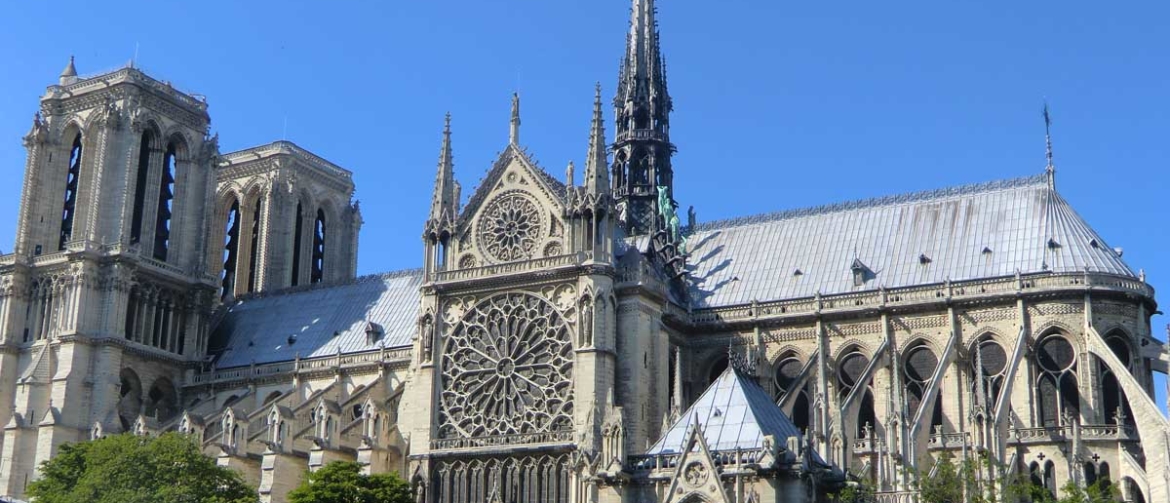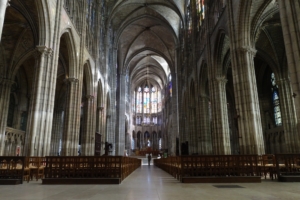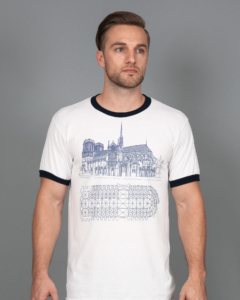
Gothic: A Revolution of Light and Space
Gothic Architecture was born, it did not evolve.
In history, nothing happens in a vacuum. As such it is often difficult to say that an a style or era is born in a specific place or at a particular time. However, in Gothic Architecture, we find somewhat of an exception to this rule. The Gothic style was born with the rebuilding of the Basilica of St. Denis on the outskirts of Paris.

Cathedral of St. Denis features flying buttresses, allowing thinner walls and larger windows.
Gothic was born out of a desire for natural light.
While the elements of the Gothic style existed prior to this building, it was at St. Denis that we find them all coming together in one place at one time. The construction of this cathedral was documented by it’s patron, the Abbott of St. Denis, the Abbott Suger. There is some debate as to whether or not he was the actual architect, however, what is clear is that Suger, as the patron of the building, influenced the style in which this building was to be created.
Like many of the time Suger equated light with the Devine. So for him, light was all important and as such, the aim in construction of the new choir was to maximize the amount of natural light that would flow into the building. The nave (the central part of the church) of St. Denis is inscribed with the following:
“For bright is that which is brightly coupled with the bright/and bright is the noble edifice which is pervaded by the new light.”
Gothic buildings were larger, but their architectural elements made them look larger still.
In stone buildings, the weight of the arches and roof tends to push the walls outward. Romanesque architecture solved this problem by making walls that were thicker and heavier. Supports were also thicker, which had the effect of segmenting the interior space, windows had to be smaller, and thus, interior light was limited. .
The revolutionary character of gothic is that it’s elements were intended to tackle the problem of weight support and distribution in a different way, with the aim of letting as much light into the building as possible.

Interior of St. Denis featuring segmented arches.
The segmented arch had the effect of pushing the weight down toward the ground, rather than out onto the walls. The flying buttress supported the remaining outward thrust of the walls, allowing the walls to become thinner and taller. Thinner walls supported by external buttresses allowed the made it possible to install larger areas of window. The ribbed vaults had the effect of supporting the weight of the ceiling, and drawing the eye away from the mass of the ceiling, making it appear lighter. Taller, thinner, lighter walls, more glass and ribbed vaults made the building physically taller and allowed the interior spaces to flow into one another. The ribbed vaults not only added support to the weight of the structure, but also focused the eye on this detail, and away from the solid mass. This, coupled with the amount of natural light, focused the eye upward, making the space look larger.
Gothic was the result of technological advancement
In the in the same way that the mass production of steel , among other advancements, allowed what we know as modern architecture to come into being, The characteristics of Gothic – the segmented arch, the flying buttress, and ribbed vaults were the front line technology of their time, and they allowed a whole new style to come into being.
Gothic was the Open Plan Architecture of it’s time – and it was popular.
A lot has been said about the ”Gothic” being a negative term. While there is some truth to this, it is also true that within 50 years, every new cathedral under construction in Western Europe was being built in the Gothic Style. There are examples of churches that were under construction in the Romanesque style that changed in style to the gothic in the middle of their construction. They feature heavy , thick walls with small adjoined to lighter, thinner walls decorated with large windows – in the same building! As such, while the term “Gothic” may have been used negatively by some in the beginning, it has been argued that this was simply a reaction by some to an architecture that was so revolutionary for its time.
